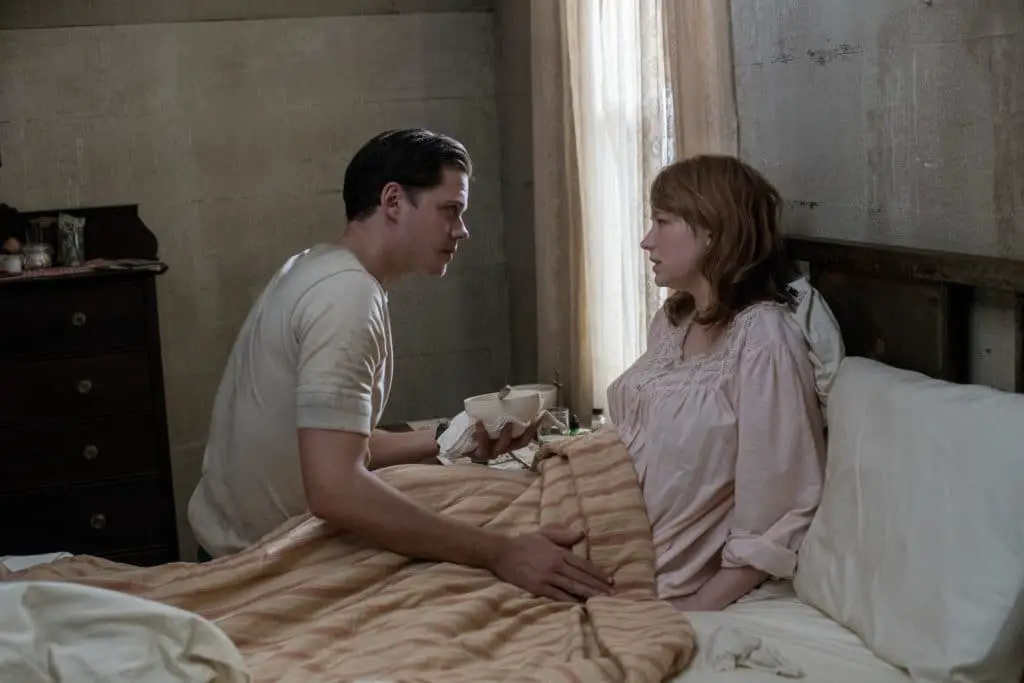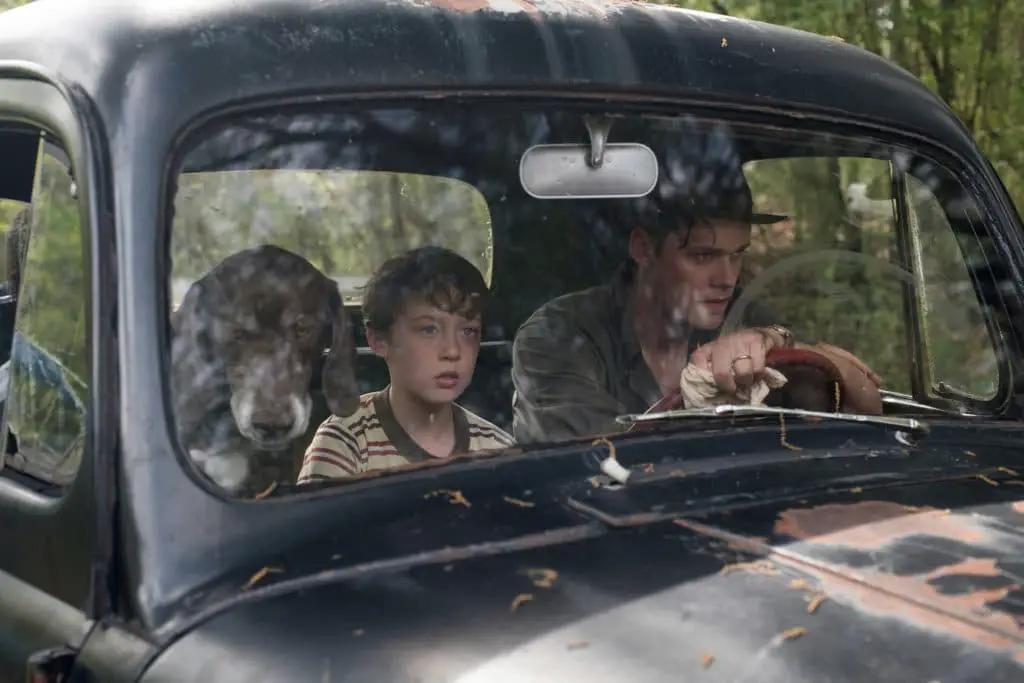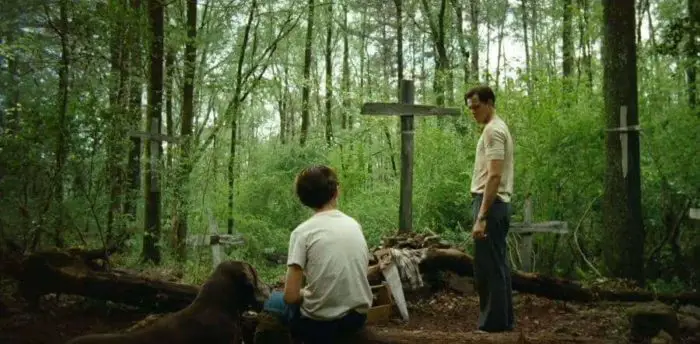Fanatical Faith, Revenge, Madness: The Meaning of The Devil All the Time (2020). The Devil All the Time: The Plot Analysis & Meaning Of The Film, Explanation Of The Ending.
Genre: Thriller, Drama, Crime
Year of production: 2020
Directed by: Antonio Campos
Actors: Tom Holland, Bill Skarsgard, Riley Keough
tagline: “Some people are just born to be buried”
Painting by Antonio Campos tries to reveal the essence of the issue of “one-story America”. Unlike the same Coens, Campos is very far from her romanticization and prefers to follow the path of darkness. This is a complex, tragic picture. The point of The Devil All the Time is that extremes are dangerous. In order not to reach them, it is important not only to believe, but also to understand what you believe in.
What is the movie about
The Devil All the Time is an adaptation of the novel of the same name by Donald Roy Pollack. The film turned out to be gloomy, tough, uncompromising.
A brief description of the content of the picture. The story begins with a voiceover. He talks about the two towns in which events will unfold – about Col Creek (West Virginia) and Knokemstiff (Ohio).
 Tom Holland played the role of Arvin. Frame from the film.
Tom Holland played the role of Arvin. Frame from the film.
By the way, the invisible narrator, who leads the viewer through the whole film, is the writer himself. According to the director’s idea, this voice is the personification of the “Voice of God” – the voice of the creator, who knows about everything that happens, as well as about the thoughts and inner feelings of the characters.
The film opens with Willard Russell, a World War II veteran, returning home. He suffers from a severe form of PTSD (post-traumatic syndrome), and he tries to find salvation first in his family, and after the death of his wife, in God.
Having failed to survive the death of his beloved wife, for some reason he decided that God was telling him to make a sacrifice… Then another one. Realizing that the spilled blood will not help him return his wife, Willard resorts to suicide in desperation. All this is witnessed by his ten-year-old son Arvin.
In parallel, the terrible story of Lenora is told – a girl born as a result of a relationship between a local preacher and a girl named Helen. One day a preacher “heard the voice of God” and killed Helen. Frightened, he decided to run away, leaving the child to its fate. He met a nice couple – Carl and Sandy. They are serial killers and they have their own faith. And Sandy’s brother, Sheriff Lee Bodecker, has his own…
Lenora and Arvin were raised as half-brother and sister by one person – his grandmother. The boy grew up with the conviction that he must always protect his sister, who, without knowing it, having matured, repeated the fate of her mother.
Arvin decides to avenge her, and at one moment the fates of all the characters in the picture are intertwined…
 Bill Skarsgard as Wil, Hayley Bennett as Charlotte. Frame from the film.
Bill Skarsgard as Wil, Hayley Bennett as Charlotte. Frame from the film.
The Devil All the Time Ending explanation
The film ends with a speech by President Lyndon Johnson explaining his decision to send more American troops to Vietnam. According to him, the main goal is to defeat communism. We are talking about a typical struggle of ideologies, which always (always!) Underlies any military conflict. But what does all this have to do with the characters in The Devil All the Time?
You can understand the meaning of the ending of the film “The Devil All the Time” if you turn to an interview with Antonio Campos. In it, he said that the tape is based on madness that arose at the intersection of religion and violence.
The ending of the film echoes its beginning. In fact, the story of Arvin began with another war. Willard was traumatized by the experience, and the experience greatly influenced the way he raised his son.
The country had just finished one war and immediately got involved in another. This war claimed many lives and led to the emergence of a new lost generation. The director gives a hint that it will always be like this: “Afghanistan, Iraq, Libya … further everywhere.” Great violence breeds small. And it is probably impossible to get out of this circle.
The meaning of the film The Devil All the Time
The picture takes up complex themes and links together sincere faith and violence. The characters in this twisted tale hide dangerous secrets, fight inner demons, and succumb to dark desires.
In one of his interviews, Antonio Campos said that his main idea was an attempt to study religious fanaticism, as well as the nature of people who often go to extremes in their relationship with God. One of the meanings of the film is that spiritual emptiness is extremely dangerous. The danger lies in the fact that a person begins to fill this void with his own ideas, which often leads to sad consequences.
 Frame from the film.
Frame from the film.
It is noteworthy that the director abandoned the idea of evaluating religion as such. The negative of everything that happens is connected precisely with the passions, actions and intentions of people who, under the guise of faith, pave the way to hell for themselves and those around them. Literally, he said the following: “Religion is a very powerful thing. Ultimately, it is run by people who have their own motives, both good and bad.”
The Devil All the Time is quite categorical about religious fanaticism. The essence of the film is to show how people distort religion, and how these distortions turn into insult, shame, violence, and other destructive behavior. Fanatic, thoughtless faith is evil. Antonio Campos makes it clear that it does not come from God, but from his antipode.
Both in the film and in the novel The Devil All the Time, the characters go to extremes, and this leads each of them to a terrible, but, alas, natural ending.
The story begins with a young man who has just returned home from the war. At the front, he saw terrible things. Alas, he does not have the opportunity to speak out – because there is no one nearby whom he could trust. Therefore, he turns to religion and has a quiet conversation with God, which helps him deal with difficult memories.
His wife’s illness cripples him. An old, unhealed trauma is opened up, and this leads to serious consequences.
 Jason Clark played the role of Carl and Riley Keough played the role of Sandy. Frame from the film.
Jason Clark played the role of Carl and Riley Keough played the role of Sandy. Frame from the film.
According to the director, he took the script to work also because he wanted to explore such a phenomenon as the faith of generations – that is, the elements of religion transmitted from father to son. Campos himself was brought up by a pious mother and a disillusioned father. He noted that he used The Devil All the Time not as an indictment of religion and faith, but as a way of examining himself.
Campos gives his interpretation of the events of the book. For him, this is the story of generations – the story of how much children receive from their fathers.
Arvin’s father suffered from severe PTSD, which he never treated. He did not have sincere faith – he simply hid his fears and complexes in it. That is, Arvin inherited a complex relationship with religion from him. In solving problems, he (also like a father) relied on violence.
We then learn that Sandy’s character is Sheriff Bodeker’s sister, and that their father left them early, thus influencing their worldview.
Each hero of the tape was somehow traumatized by their parents. Therefore, we can say that its main meaning is in the continuity of generations.
Answering a question about the film, Campos emphasized that it was shot in the style of southern gothic – and this is important. This dark genre is characterized by motifs of alienation and madness, as well as deep symbolism and increased attention to the religious aspects of Puritan society. This genre also addresses social problems such as racism, poverty, violence and incest.
The genre absorbed many elements of classic Gothic literature, but at the same time remained closely connected with the life and traditions of the American South.
 Frame from the film.
Frame from the film.
We can say that The Devil All the Time is a kind of an anthology of human destinies. The lines of characters are closely intertwined throughout the picture. They all play an important, often destructive, role in each other’s lives.
But what brought the heroes together? A series of coincidences, or is it still divine intervention? The voice-over itself answers this question: both.
Serial killer Carl and Sandy met at the same diner as Arvin’s parents. Carl was the first to see an empty seat at the bar, but out of respect for the veteran, he gave the chair to Willard. Because of this, he was literally face to face with his future wife.
Sandy was the sister of Sheriff Bodecker, who got her a job at a diner where she met Carl. It was Bodecker who took the young Arvin away after his parents’ death.
Carl and Sandy killed Lenore Roy’s father. Therefore, the girl stayed with Arvin’s grandmother and became his sister. Arvin, having received an important lesson from his father in childhood, always stood up for his sister, and his revenge for her death also launched a chain of events and fateful meetings.
In their analysis, viewers trying to find a hidden meaning in the film offer the following explanation for the ending: by inserting Johnson’s speech, the film emphasizes the nature of American violence. There is also a hint that Arvin will most likely join the forces in Vietnam. The key to all this is that the cycle of violence will continue to repeat itself.
Similar films
Here are a few films that are similar in meaning to The Devil All the Time:
- “The Place under the Pines” (USA, 2012). Luke’s fate surprisingly changes when he finds out that he has a son and decides to take part in his upbringing;
- “Hell” (Netherlands, USA, 2016). Liz is desperate to control her demons and escape the persecution of a zealot demonic preacher;
- “No Country for Old Men” (USA, 2007). One day, a war veteran embezzles money from drug dealers. This provokes a whole chain of bloody events.







